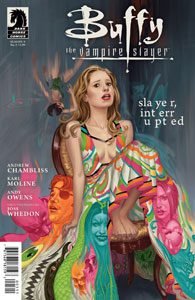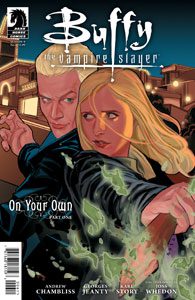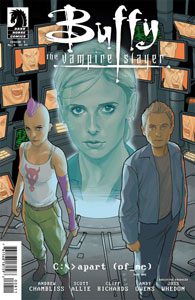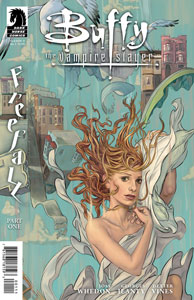After Season 8, Dark Horse’s canonical “Buffy” comics do what the TV series did more than a decade prior: split into two series. While “Angel & Faith” go off to do their own thing, “Buffy” Season 9 sets up shop in San Francisco and welcomes excellent new lead scribe Andrew Chambliss, who had written for “Dollhouse.” Here are my reviews of Issues 1-10 of the 25-issue Season 9.
“Freefall” (Issues 1-4, September-December 2011)
“Buffy” Season 9 opens in similar thematic fashion to Season 4. Although Buffy has conquered massive threats, she’s not so great with daily life. This has long been the conundrum of our favorite Slayer. Shouldn’t her Slaying prowess give her more overall confidence? Maybe, but the fact that she struggles with things like finances makes her endearing and relatable. Chambliss and Joss Whedon tap into Buffy’s scary adult life in an amusing opening issue, accented by the adorable yet vibrant art from returning penciller Georges Jeanty and colorist Michelle Madsen and new inker Dexter Vines.
Issue 1 finds the Slayer trying to piece together her drunken night the next morning, and while that’s standard stuff and doesn’t have a surprising payoff (she was simply drunk and did crazy things like juggling), what’s great is the way it introduces us to the new setup while being funny. San Fran is the new backdrop, Buffy has two roommates and a bedroom where she can touch opposite walls simultaneously, and she’s working as a barista.
Xander and Dawn are weirdly cold toward Buffy (and toward each other, apparently because Xander forgot Dawn’s birthday, but that might be a red herring), not doing any patrolling with her and trying to start a domestic life. Willow is more understandably icy toward Buffy, as she has lost her magic abilities as per the Seed’s destruction. Spike purposely keeps his distance, out of respect for Buffy’s desire for a normal life. “Freefall” – the final three issues on which Chambliss goes solo – is mostly from Buffy’s POV, allowing us to reconnect with her on a personal level after the bombast that ends Season 8.
The four-parter introduces two strong new characters. Severin can suck power out of vampires’ skulls, leaving them as human corpses. And Detective Dowling, like Kate is to Angel, is the one cop who understands Buffy is the good guy. I’m happy that all the cops know about the supernatural world, so Buffy doesn’t have to ever again explain what Slayers or vampires are. Zompires – vampires that attack humans like mindless creatures, since their demon nature is unstable because of the Seed’s destruction (or something like that) – are new threats. So while there’s no new magic in the world, the destruction of the Seed will provide new twists.
And rogue Slayer Simone lurks. While she’s a familiar villain from Season 8 (and the notion of rogue Slayers is nothing new, dating back to Faith in Season 3), her bitterness toward Buffy has been established, and I think she’ll make a solid Big Bad. “Freefall” is a smooth recovery from the weak ending to Season 8.

4.5 stars

“Slayer, Interrupted” (Issue 5, January 2012)
Dream stories are not my favorite type of “Buffy” yarn, so “Slayer, Interrupted” (not to be confused with Issues 56-59 of the Classic series) wasn’t going to rank highly with me. Still, it’s always a treat to get art from the “Fray” team of Karl Moline (pencils) and Andy Owens (inks), with Madsen on colors, and there’s key information revealed here.
The Scythe, located atop a trash pile the First Slayer points Buffy to, is a key to returning magic to the world. And in a classic final-panel surprise, we learn Buffy is pregnant. This casts new light on Buffy’s drunken spree from Issue 1, when she is flirting with Riley and Xander, among others. Hmmm …
3.5 stars

“On Your Own” (Issues 6-7, February-March 2012)
In Issue 6’s flashback scenes, it’s great to learn more about Nikki Wood (the Slayer eventually killed by Spike, as revealed in “Fool For Love,” 5.7), who briefly goes into hiding with her son Robin – and with help from her Watcher, Crowley, in order to pursue a normal life. She’s able to kill a vampire while pregnant and without powers during her Cruciamentum — something also chronicled in “It’s All About the Mission” from 2004’s “Tales of the Slayer, Vol. 4” – such is the power of a mother’s protective love for her unborn child.
However, Nikki returns to her calling because being a Slayer is ingrained in her. I like how this story illustrates that being a Slayer isn’t like being drafted into an army: When you’re infused with the power, you’re also infused with the need to use it to fight evil.
In present day, Issue 6 also features nice bonding scenes between Spike and Dowling, as Spike teaches the detective about vampires, and a chat between Buffy and Dawn. Here Chambliss showcases his knack for Whedonesque dialog as Buffy runs down potential impregnators: “Riley, who’s married. Andrew, whose name I’m not sure why I’m saying …”
In a twist that caused brief controversy among some readers, Buffy decides to have an abortion. However, Chambliss uses the abortion thread as a mislead, because Issue 7 follows with the biggest WTF moment in the whole “Buffy” narrative up to this point. As Buffy, Spike and Dowling fight a nest of zompires, Buffy’s mechanical arm gets ripped off. As she says in the final panel: “I’m a f$$@ing robot!” The narrative shift reminds me of “Bad Girls” (3.14), when it seems like we’re in for a clichéd story of Buffy being framed for murder, but instead Giles immediately knows Faith is framing her and we move into the meatier story of Faith’s fall to the dark side.
But Buffy being a robot is a crazier twist, and in a lesser comic series, this could be an infamous moment, one that leads to people saying years later “Yeah, I stopped reading ‘Buffy’ when she was suddenly a robot.” I’m on board, though. I want to find out how Chambliss writes his way out of this corner, and the sci-fi concept of someone learning they’re not real hasn’t been done on “Buffy” before. (Dawn is created by magic, sure, but she’s not artificial, and Ted and the Buffybots know they are robots.) Chambliss has already earned my trust.
4.5 stars

“Apart (of Me)” (Issues 8-10, April-June 2012)
With Scott Allie co-writing and Cliff Richards penciling, “Apart (of Me)” builds on the Buffybot surprise with a bizarre but strong three-parter. Andrew – meaning well, but totally screwing things up – had set up Buffy’s body in a nice suburban house and job to keep it safe from bad guys, while transferring Buffy’s mind into a new Buffybot. (This builds from Issue 1, so it turns out that drunken night was the ultimate in craziness after all, as Buffy literally lost her mind.) Andrew’s scheme to protect Buffy makes no sense, especially since Simone tracks down Buffy’s body. And also, the Buffybot with Buffy’s mind is in danger this whole time, too. So really, he just doubled the chances that Buffy would be killed in one way or another. It’s remarkable that such a scientific genius is so bad at basic logic.
Even if “Apart (of Me)” falls apart when we mull Andrew’s plan, it’s a juicy (if familiar to “Dollhouse” fans) sci-fi think piece about what defines humanity. Like “Dollhouse’s” Echo, the blank slate in Buffy’s body begins to develop a mind of her own, but luckily she believes the real Buffy should return to this body. Buffy (in the Buffybot body) is a bit blasé about these events, and I was itching for everything to be set back to normal just because this is all so weird. But, of course, that’s the point.
To take the mindtrip further, this is at least the third time Buffy has fought “herself” – which, now that I think about it, explains her relatively casual attitude about being separated from her body. She and Faith memorably swap bodies in “Who Are You” (4.16), and there’s the less memorable Dark Buffy in Issue 17 of the Classic comics. Somewhat surprisingly, she never fights a Buffybot in the show – the Buffybots are always programmed for good – but in this comic she, as a Buffybot, fights “herself.” Whew.
Thematically, Buffy gets a hint of what a normal life could be like in “Apart (of Me),” but the Faux Buffy notes that she didn’t feel she had earned her nice suburban life. So Buffy understands the importance of earning that life for herself. And, in a nice happy twist for our heroine, Buffy gets a job offer from Kennedy at the same time she is freshly inspired to do something worthwhile again.
Spike’s “A Dark Place” miniseries also springs from this arc, with Buffy and Spike parting on good terms. He loves her, and always will, but recognizes she’s better off without him – even though she kind of wants him to stay and help in the fight against Simone. While I’ve never been an obsessive Buffy-Spike ’shipper, I do always sympathize with Spike’s POV, and I admit that the writing of their relationship (or lack thereof) in Season 9 has been excellent.
Speaking of relationships, Xander and Dawn have had a slow-burn feud going throughout these first 10 issues. I’ll be disappointed if it’s nothing more than “they aren’t wired for domestic bliss,” although I do think it’s clear – as they assist Dowling in tracking down his partner-turned-zompire – that they aren’t wired for avoiding the fight against evil.
Oh, and here’s a fun trivial note: Paralleling Dowling staking his partner, Xander mentions Jesse! He does remember his old friend!
4.5 stars
Click here for an index of all of John’s “Buffy” and “Angel” reviews.

